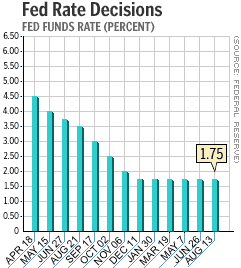NEW YORK (CNN/Money) - The Federal Reserve left a key interest rate unchanged Tuesday but said the risks to the U.S. economy now are tilted more toward weakness than inflation.
As widely expected, Fed policy makers decided to leave their target for the federal funds rate, an overnight bank lending rate, unchanged at 1.75 percent, the lowest level in more than 40 years. All 12 policy makers, including Chairman Alan Greenspan, approved the decision.
In the closely watched statement accompanying its decision, the Fed said that, while its monetary policy was already providing plenty of stimulus to the economy and that productivity growth also would help push the economy to growth, the economy was in greater danger now than when policy makers last met in June.

"The softening in the growth of aggregate demand that emerged this spring has been prolonged in large measure by weakness in financial markets and heightened uncertainty related to problems in corporate reporting and governance," the Fed said in its statement.
The Fed also left its symbolic discount rate unchanged at 1.25 percent.
The decision was widely expected but was disappointing to some on Wall Street, where stock prices fell. Treasury bond prices rose.
"The Fed will wait to see at least another month's worth of economic data before it makes a decision to ease," Bank One chief economist Diane Swonk told CNNfn's Money Gang program. "They want to see whether or not [weak] July data were more of an aberration or a trend -- two months will give them more cover to ease further."
The fed funds rate forms the basis for banks' prime lending rates and affects the cost of borrowing for consumers and businesses. The central bank cuts rates when it wants to stimulate the economy and raises them when it wants to slow the economy down and fight inflation.
It cut rates 11 times in 2001 to fight a recession that the National Bureau of Economic Research said began in March of that year. Low rates also helped keep mortgage rates low, fueling a hot housing market that increased homeowners' equity and also boosted spending.
Click here for more on the Fed and rates
It may seem hard to believe now, but as recently as three months ago, just before the Fed's May meeting, most economists thought the Fed would be raising rates by at least a quarter percentage point in August.
That expectation was turned on its head by persistent stock market weakness throughout June and July, raising fears that the weakness could erode consumer and business confidence and slow the economy down again.
| |
 Related stories
Related stories
| |
| | |
| | |
|
Then, in rapid succession two weeks ago, the Commerce Department drastically revised its readings of gross domestic product (GDP) last year to show contraction in three straight quarters, the Institute for Supply Management reported a dramatic slowdown in manufacturing activity in July, and the Labor Department said job growth in July was nearly dead in the water.
Wall Street's alarm bells really started ringing at that point, and rumors spread that a rate cut was on the way.
But subsequent data showed continuing economic growth, however weak, and the stock market began to show signs of having reached a bottom. Gradually, expectations for a rate cut diminished -- though some on Wall Street are still calling for one, and a handful of banks expect one by the end of the year.
The Fed's statement seemed designed to specifically avoid promising a rate cut. It did not say, for example, that policy makers were "closely monitoring" the economy, verbiage that's been taken in the past to hint at a cut possibly being made between policy meetings.
"They're acknowledging reality. They're saying, 'We'll do what we have to do if future events warrant,' but I still don't think they plan on doing anything anytime soon," said Wayne Ayers, chief economist at Fleet Boston Financial and a former Fed economist.
The Fed is scheduled to meet again on Sept. 24. Between now and then, they will get information on August unemployment, the results of the Institute for Supply Management's August and September manufacturing surveys, August and September surveys of consumer confidence by the Conference Board and the University of Michigan, and many more data.
The Commerce Department said Tuesday that retail sales rose in July, a hopeful sign for consumer spending, which fuels about two-thirds of the total economy. But much of that strength was the result of robust automobile sales, driven by aggressive dealer incentives, so it's still too early to tell if spending will hold steady or begin to fade.
At an economic forum in Waco, Texas, President Bush said he was confident the economy would bounce back from recent weakness.
And, as they'd done all day, members of Bush's Cabinet echoed Bush's sentiment after the Fed decision, with Treasury Secretary Paul O'Neill reiterating that he saw U.S. economic growth of between 3 and 3.5 percent this year and Glenn Hubbard, chairman of the White House Council of Economic Advisers, saying the Fed's decision to leave rates alone was a sign the recovery was on track, according to Reuters reports.

|

